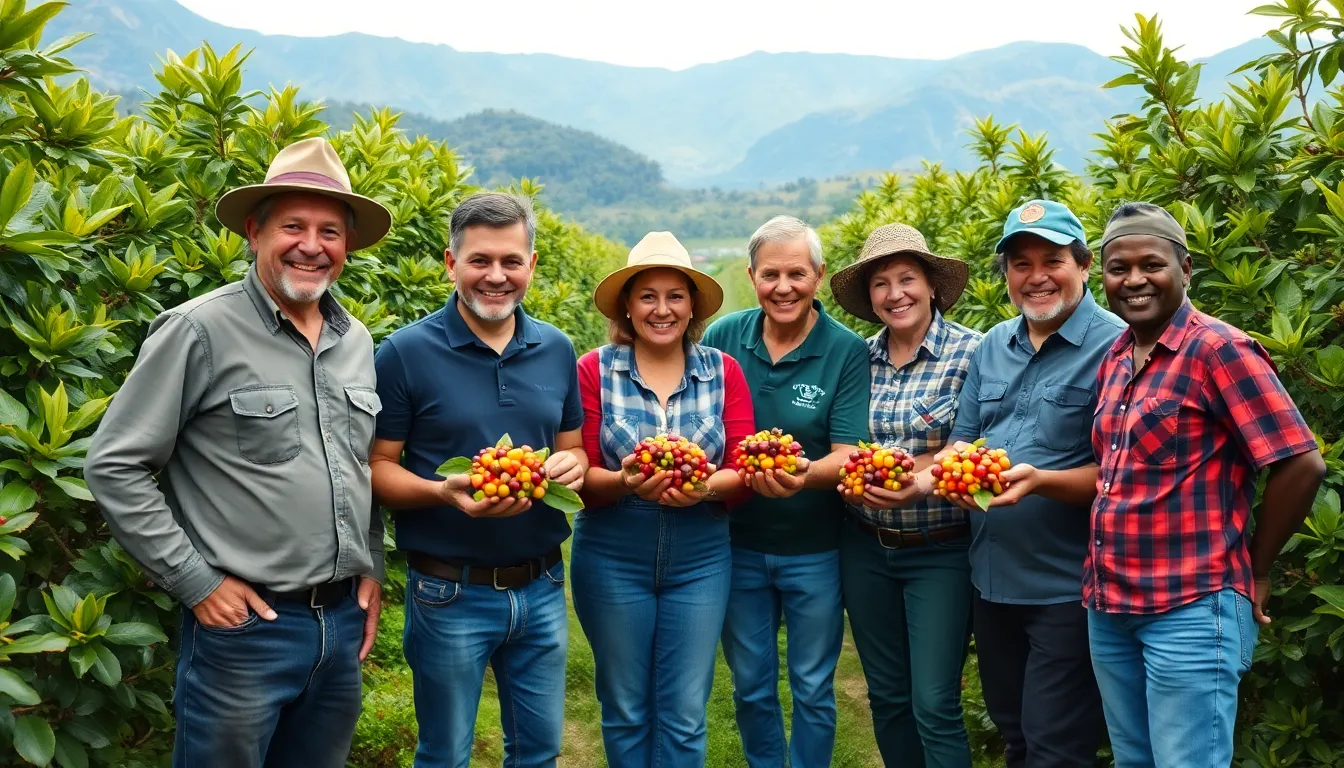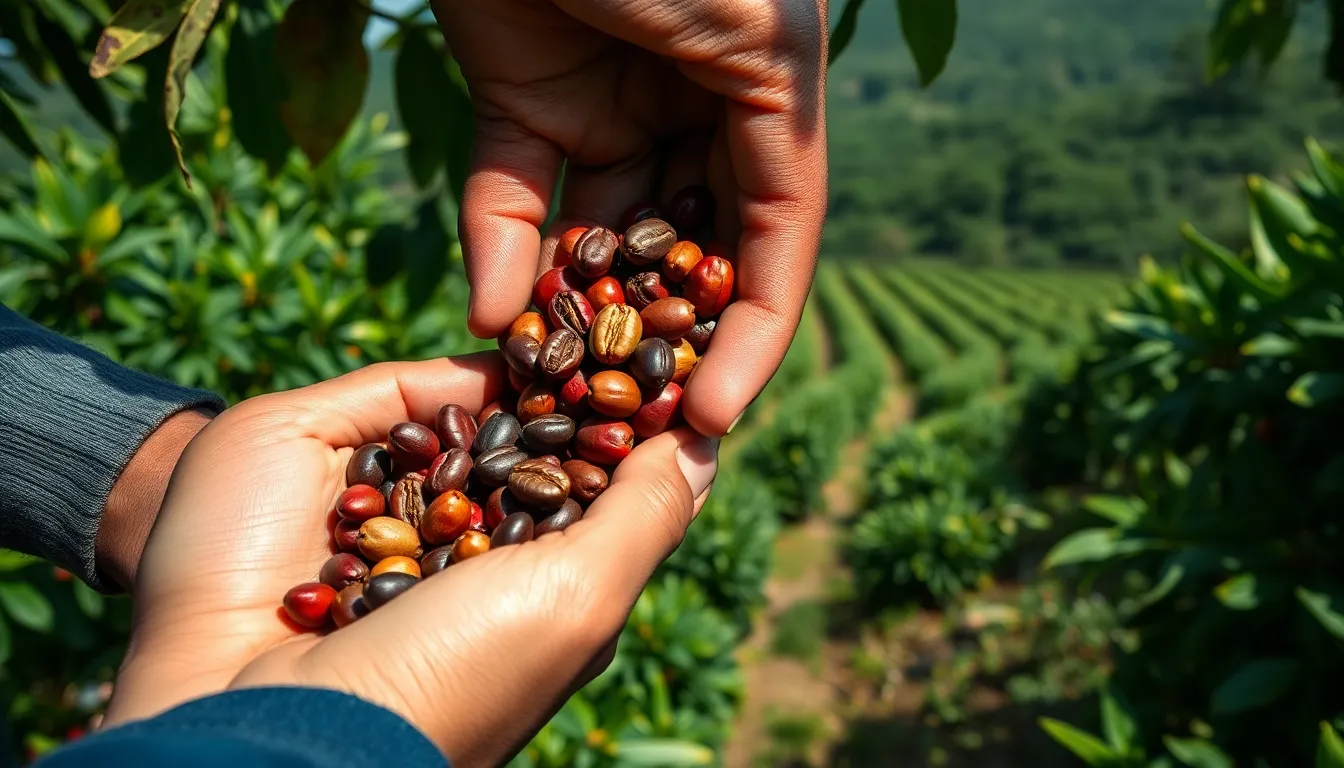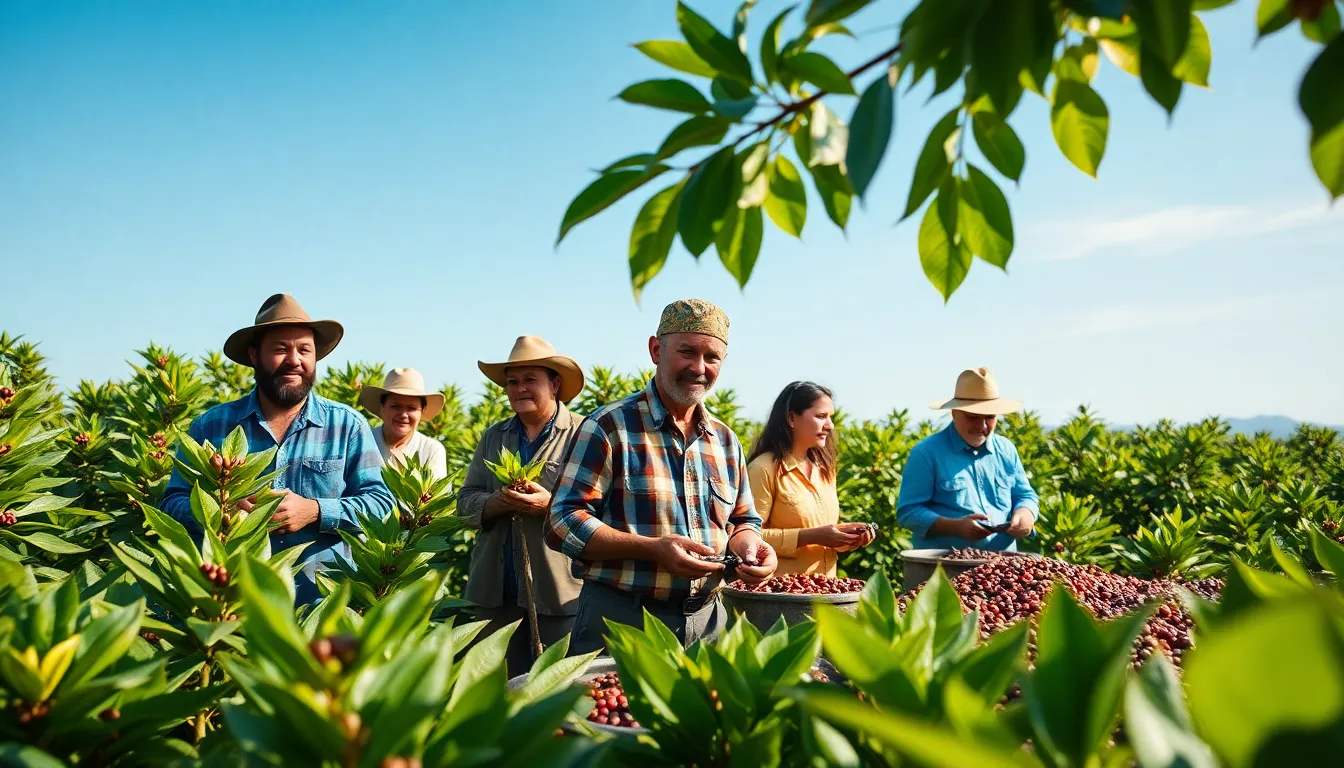Ever wondered what “farm to cup” really means in your morning coffee ritual? This movement is revolutionizing how we experience coffee, connecting you directly with the journey your beans take from distant farms to your favorite mug.
Farm to cup isn’t just another trendy phrase—it represents a fundamental shift in coffee consumption. By shortening the supply chain and emphasizing direct relationships with farmers, this approach ensures you’re getting fresher, more ethically sourced coffee while supporting the people who grow it. Your coffee doesn’t just taste better—it tells a story of sustainability, fair wages, and environmental responsibility that begins in coffee-growing regions and ends right in your kitchen.
What Is Farm to Cup Coffee?
Farm to cup coffee represents a direct connection between coffee farmers and consumers, eliminating unnecessary intermediaries in the traditional coffee supply chain. This transparent approach ensures you’re drinking coffee that’s been carefully tracked from its origin to your mug. Unlike conventional coffee distribution models with multiple middlemen, farm to cup creates a shorter path from producer to consumer.
Coffee beans travel through fewer hands in this model, often moving directly from farms to roasters to your cup. Roasters who embrace farm to cup principles frequently visit the farms, building relationships with growers and gaining intimate knowledge of cultivation practices. These direct relationships lead to higher quality standards and more consistent flavor profiles in your coffee.
The farm to cup movement emphasizes traceability, allowing you to know exactly where your coffee comes from and how it was produced. Many specialty coffee shops now provide detailed information about the farms, regions, and exact processing methods used for each coffee they serve. This transparency builds trust and enhances your appreciation for the complex journey behind each brew.
For example, Rikki Manny discovered during a visit to a Colombian coffee farm that the farmer had implemented innovative drying techniques that preserved delicate flavor notes often lost in conventional processing. This knowledge transformed how Rikki approached coffee selection, prioritizing producers who demonstrated exceptional care in their post-harvest handling.
Farm to cup coffee typically commands premium prices, but these higher costs translate directly to better compensation for farmers and superior quality in your cup. The focus on quality over quantity encourages sustainable farming practices and supports the livelihood of coffee-growing communities around the industry.
The Journey From Farm to Cup

Coffee’s journey from farm to cup is a meticulous process that transforms a humble cherry into the aromatic brew you enjoy each morning. This path involves multiple stages, each adding distinct character and quality to your coffee experience.
Cultivation and Harvesting
Coffee thrives within the “Bean Belt,” a geographic region encompassing parts of Central and South America, Africa, and Asia. Arabica and Robusta stand as the two primary species cultivated worldwide, with each plant requiring 3-4 years to mature and produce fruit. These coffee cherries develop two seeds (beans) inside, which eventually become your morning brew. Harvesting techniques vary by region—traditional hand-picking ensures only perfectly ripe cherries are selected, offering superior quality and flavor profiles. Mechanical harvesting provides efficiency but sacrifices the precision of manual selection, creating a trade-off between volume and quality.
Processing Methods
Processing transforms freshly harvested cherries into dried green beans through three distinct approaches. The washed process removes pulp mechanically before fermenting away the sticky mucilage coating the beans, resulting in bright, clean flavors with pronounced acidity. Natural processing takes a different approach—entire cherries dry in the sun before hulling, allowing fruit sugars to infuse the beans and create complex, fruity flavor notes. The honey process strikes a middle ground by leaving some mucilage on the beans during drying, developing balanced sweetness and enhanced body in the final cup.
Roasting and Distribution
Green coffee beans undergo a remarkable transformation during roasting, passing through distinct drying, browning, and development stages. Heat triggers hundreds of chemical reactions inside each bean, creating the complex flavors, aromas, and colors you associate with coffee. After roasting, beans are ground to exact consistencies based on brewing methods—finer for espresso, coarser for French press. Distribution networks then deliver fresh coffee to cafés and retail outlets, where various brewing techniques extract the unique characteristics developed through cultivation, processing, and roasting. Each step in this journey contributes distinct elements to your coffee’s final taste profile.
Benefits of Farm to Cup Coffee

Farm to cup coffee delivers multiple advantages beyond just superior taste. This direct sourcing model creates positive impacts throughout the entire coffee network, from environmental protection to economic fairness.
Environmental Sustainability
Farm to cup coffee embraces sustainable cultivation practices that protect our planet. Shade-grown coffee methods preserve natural biodiversity by maintaining forest canopies where coffee plants thrive alongside native trees and wildlife. Organic farming techniques eliminate harmful pesticides and synthetic fertilizers, resulting in healthier soil and water systems. These environmentally conscious approaches reduce deforestation rates in coffee-growing regions and lower the overall carbon footprint of coffee production. By supporting these sustainable practices, you’re helping combat climate change while enjoying your morning brew.
Fair Trade and Ethical Sourcing
Direct relationships between roasters and farmers eliminate unnecessary middlemen who often capture much of the profit. Coffee farmers receive significantly higher prices for their crops through the farm to cup model, sometimes earning 2-3 times more than in traditional supply chains. This increased income allows farmers to reinvest in their operations, improve living conditions, and support their local communities through better healthcare and education. The transparency inherent in farm to cup coffee lets you trace your coffee back to its exact origin, confirming the ethical standards maintained throughout production. Each purchase becomes a vote for fair compensation and dignified working conditions for the people who grow your coffee.
- Higher Quality Coffee: Direct farmer-roaster partnerships enable strict quality control at every stage. Roasters select only premium beans and can influence cultivation techniques to enhance flavor profiles. This careful oversight results in coffee with more complex aromas and distinctive taste characteristics.
- Consumer Empowerment: Complete transparency about origin, growing conditions, and pricing gives you the information needed to align your purchases with your values. You can make choices that support exact farming communities or environmental initiatives.
- Stronger Farmer-Roaster Partnerships: Long-term relationships built on trust and mutual respect create stability for coffee farmers. These enduring connections encourage ongoing quality improvements and innovation in cultivation techniques, benefiting everyone in the supply chain.
Key Players in the Farm to Cup Movement

The farm to cup movement is driven by several key stakeholders who actively transform traditional coffee supply chains. These entities focus on creating sustainable and equitable relationships that benefit both producers and consumers while ensuring exceptional coffee quality.
Direct Trade Coffee Companies
Direct trade coffee companies establish relationships directly with coffee farmers, bypassing intermediaries and certification bodies. These companies typically pay farmers up to 25% more than fair trade prices, creating a substantial economic impact for coffee-growing communities. Coffee roasters who practice direct trade often visit farms annually to select exact lots and develop long-term partnerships based on quality and sustainability. Unlike rigid certification systems, direct trade relationships adapt their standards to each unique partnership, addressing plantation management, environmental concerns, and social factors exact to each farm. This flexibility allows for continuous improvement and innovation while maintaining high standards for both quality and ethics.
Farmer Cooperatives
Farmer cooperatives serve as collective entities representing coffee producers and managing the cultivation and initial processing stages. These organizations focus intensively on developing optimal growing conditions and maintaining land health to produce specialty-grade coffee beans. Cooperatives give farmers increased negotiating power when dealing with buyers and provide a unified voice for implementing sustainable practices across multiple small farms. Their expertise in perfecting specialty coffee is crucial, as producing exceptional beans requires precise attention to altitude, climate, and cultivation techniques. Through shared resources and knowledge, cooperatives help individual farmers achieve quality standards that would be difficult to maintain independently, creating a stronger position in the competitive specialty coffee market.
How to Identify Authentic Farm to Cup Coffee

Farm to cup coffee celebrates transparency and quality through every stage from cultivation to brewing. Recognizing genuine farm to cup coffee requires attention to several key characteristics that distinguish it from conventional coffee options.
1. Origin Transparency
Authentic farm to cup coffee provides exact details about where the beans originated. Look for coffees that clearly identify the farm name, cooperative, or exact region of cultivation. These coffees typically come from the “Bean Belt” – high-altitude areas across Central and South America, Africa, and Asia with ideal growing conditions. Premium producers often include information about the altitude, soil conditions, and even the name of the farmer who cultivated the beans.
2. Processing Methods
The method used to process coffee cherries significantly impacts flavor and authenticity. Genuine farm to cup coffees highlight their processing techniques:
- Washed (Wet) Process: Involves de-pulping cherries, fermenting to remove mucilage, washing, and drying, resulting in clean, bright flavor profiles
- Natural (Dry) Process: Cherries are sun-dried whole before hulling, creating fruitier and more complex flavor notes
- Honey Process: A middle-ground approach where some mucilage remains on the bean during drying, balancing sweetness and body
Transparent producers emphasize these details because they demonstrate the care taken during crucial post-harvest handling.
3. Quality Control and Coffee Grade
High-quality farm to cup coffee undergoes stringent sorting and grading. After drying and milling, beans get sorted by size, weight, and color to eliminate defects. Specialty-grade coffees often undergo machine sorting for consistency before roasting, with detailed information about the coffee’s grade often appearing on packaging or online descriptions.
4. Traceable Supply Chain
A hallmark of authentic farm to cup coffee is minimal intermediaries between producer and consumer. True farm to cup operations maintain documentation showing how beans traveled from exact farms to your cup. This traceability ensures verification of the coffee’s journey and properly recognizes farmers for their contribution to the final product.
5. Sustainability and Ethical Practices
Many genuine farm to cup coffees come from farms implementing sustainable agriculture techniques. These producers often showcase their commitment to environmental stewardship, biodiversity protection, and ethical labor practices. Their packaging or websites frequently detail exact sustainability initiatives, from water conservation to shade-grown cultivation methods that preserve forest canopies.
By examining these five aspects of your coffee purchase, you’ll develop the ability to distinguish truly authentic farm to cup offerings that honor both quality and the people behind the beans.
The Future of Farm to Cup Practices

The future of Farm to Cup practices centers on deepening connections throughout the coffee supply chain while embracing sustainability and ethical sourcing principles. Coffee companies committed to this philosophy actively pursue a “Never Stop Learning” ethos, continuously refining their create to enhance coffee quality and create better futures for both producers and consumers.
Many specialty coffee businesses are expanding their direct relationships with farms through more frequent origin trips. Stone Creek Coffee exemplifies this approach by sending employees to partner farms, providing firsthand experience with cultivation and processing methods that strengthen quality commitments and foster mutual learning opportunities.
Technological advancements now enable greater transparency in tracking coffee from seed to cup. Digital platforms allow consumers to scan QR codes on packaging to view detailed information about the farm, processing methods, and even meet the farmers virtually through video content.
Environmental sustainability initiatives are gaining prominence as climate change threatens traditional growing regions. Forward-thinking companies collaborate with farmers to carry out regenerative agricultural techniques, water conservation systems, and carbon-neutral processing facilities to protect both coffee quality and ecological balance.
Economic sustainability receives equal attention in evolving Farm to Cup models. Beyond paying premium prices, progressive coffee companies invest in community development projects, education programs, and infrastructure improvements that create resilience in coffee-growing communities facing market volatility.
Training programs for café teams continue to expand, ensuring baristas understand the full journey of the beans they prepare. This knowledge transfer completes the Farm to Cup circle, allowing those who serve the coffee to communicate its story authentically to consumers who increasingly value connection to origin.
Conclusion
The farm to cup movement represents a revolutionary shift in how we experience coffee. By choosing these mindfully sourced beans you’re not just enjoying superior flavor but actively participating in a more equitable and sustainable coffee network.
Your daily cup now carries purpose beyond caffeine—it supports farming communities creates environmental benefits and delivers exceptional quality through shortened supply chains. Each sip connects you directly to the hands that cultivated your coffee.
As technology advances and consumer awareness grows the farm to cup model will continue evolving making transparency and ethical sourcing increasingly accessible. Your purchasing decisions have real impact helping to shape a coffee industry where quality authenticity and human connection matter just as much as the perfect brew.
Frequently Asked Questions
What is farm to cup coffee?
Farm to cup coffee refers to a direct connection between coffee farmers and consumers that eliminates unnecessary intermediaries. This model ensures coffee is carefully tracked from its origin to your mug, resulting in higher quality standards and more consistent flavor profiles. It emphasizes traceability, allowing you to know exactly where your coffee comes from and how it was produced.
How does farm to cup differ from traditional coffee supply chains?
Farm to cup significantly shortens the traditional supply chain by fostering direct relationships between farmers and consumers. This approach eliminates numerous middlemen, ensuring fresher coffee, better quality control, and more ethical sourcing. Farmers receive fair compensation for their work, while consumers enjoy coffee with more complex flavors and a transparent story behind each cup.
What are the environmental benefits of farm to cup coffee?
Farm to cup coffee often incorporates sustainable cultivation practices like shade-grown methods and organic farming, which protect biodiversity and reduce carbon footprints. Without pressure to mass-produce, farmers can focus on environmentally responsible techniques. These practices preserve local ecosystems, conserve water, and minimize chemical use, making farm to cup coffee a more environmentally conscious choice.
Is farm to cup coffee more expensive than regular coffee?
Yes, farm to cup coffee typically commands premium prices compared to mass-produced coffee. However, these higher costs directly benefit farmers who receive fair compensation for their quality crops. The premium also supports sustainable farming practices, community development, and superior processing methods. Many consumers find the enhanced quality, ethical sourcing, and environmental benefits worth the additional cost.
How can I identify authentic farm to cup coffee?
Look for five key characteristics: clear origin transparency (specific farm or region), detailed processing methods, information about quality control measures, minimal intermediaries in the supply chain, and evidence of sustainability practices. Authentic farm to cup coffee brands will openly share this information and often have direct relationships with named farmers or cooperatives they work with regularly.
What role do farmer cooperatives play in the farm to cup movement?
Farmer cooperatives represent coffee producers collectively, enhancing their negotiating power in the market. They focus on creating optimal growing conditions to produce specialty-grade coffee. By sharing resources, knowledge, and expertise, cooperatives help individual farmers achieve high-quality standards. This collective approach strengthens farmers’ positions in the competitive specialty coffee market while maintaining direct trade relationships.
How does farm to cup impact coffee quality?
Farm to cup significantly enhances coffee quality through direct farmer-roaster partnerships that encourage meticulous attention to cultivation, harvesting, and processing. When farmers receive fair prices, they can focus on quality over quantity, experimenting with innovative techniques. Direct feedback loops between farmers and roasters lead to continuous improvement, resulting in coffee with more complex, distinctive flavor profiles and greater consistency.
What is the future of farm to cup coffee?
The future of farm to cup coffee involves deeper connections throughout the supply chain with expanding direct relationships between businesses and farms. Technological advancements are enabling greater transparency, allowing consumers to track coffee from seed to cup. The movement is increasingly focusing on environmental sustainability initiatives in response to climate change and economic sustainability efforts that invest in community development and resilience.
What coffee varieties are typically used in farm to cup coffee?
Farm to cup coffee primarily features Arabica varieties, known for their complex flavors and grown in the “Bean Belt” regions around the world. Some producers also work with high-quality Robusta beans. The emphasis on direct relationships allows for experimentation with rare, heirloom, and region-specific varieties that might otherwise be overlooked in mass production, offering unique flavor profiles unavailable in conventional coffee.
How does farm to cup coffee support coffee farmers?
Farm to cup coffee enables farmers to earn significantly higher prices—often 50-300% more than commodity rates. This increased income allows them to invest in their farms, improve living conditions, support their families, and develop their communities. The direct relationship model also provides farmers with valuable feedback, technical support, and sometimes pre-financing, creating economic stability and fostering innovation in farming practices.


























